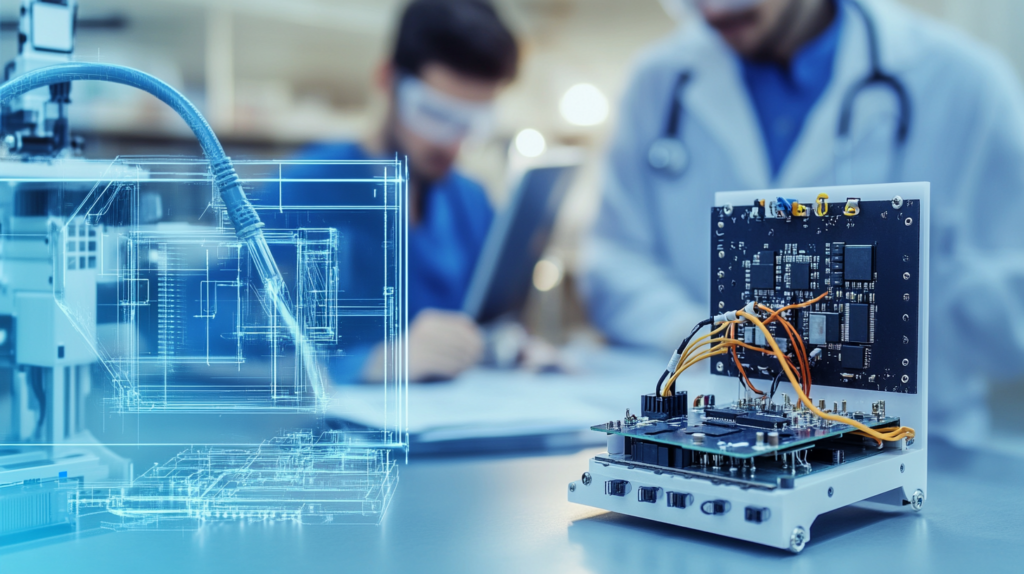Table of Contents
The painful reality of medical device engineering?
If you lose access to your source files — CAD, Gerbers, firmware, or documentation — you haven’t just lost data. You’ve lost time, regulatory momentum, and control of your entire product lifecycle.
It happens more than you think. A Chinese manufacturer disappears. An internal team member leaves. The original design firm won’t release files. And suddenly, your device exists physically — but not digitally.
No source means no freedom. And rebuilding isn’t simple. It’s brutal.
Why Source Files Are the Real IP in Medical Device Engineering
In medical device engineering, your files are your product. If you can’t open, edit, validate, or transfer them — you don’t control your technology.
And when that happens, your options collapse:
- No modifications without redoing the whole design
- No ability to validate or explain historical decisions
- No regulatory traceability
Worse: many teams realize this only after they’ve committed to scale, raised capital, or submitted to the FDA.
We’ve helped founders dig themselves out of this situation. But we’d much rather help you avoid it.

What It Really Costs to Rebuild a Device Without Source Files
Here’s what experienced medical device engineering teams know — and what many startups learn the hard way:
🧠 Medical Device Engineering: 3 Brutal Costs of Rebuilding Without Source Files
| Cost | What Most Teams Assume | What Actually Happens | Bold, Actionable Advice |
|---|---|---|---|
| 1. Redundant Engineering = Burned Capital | “We’ll just reverse-engineer the board/case/firmware.” | Reverse engineering without original CAD, Gerber, or firmware leads to months of extra work, failed compatibility, and revalidation. You re-spend R\&D budget on what you’ve already paid for. | If source files are missing, scope a forensic recovery plan: BOM extraction, circuit tracing, 3D scanning. Then rebuild with version control. Track hours as if it’s new dev work — because it is. |
| 2. Regulatory Setback = Lost Market Window | “We’ll update the tech file after the rebuild.” | Without source-aligned DMR/DHF, your FDA or CE submission is broken. Every missing traceability link resets validation. Result: missed audits, delayed funding, lost launch dates. | Reconstruct DHF/DMR in parallel with engineering. Include retrospective rationales, testing, and documented assumptions. Flag any recreated element as “revalidated.” |
| 3. Product Drift = Unstable Quality | “We’ll get it working again — it doesn’t need to be identical.” | The rebuilt product looks right but behaves unpredictably. Thermal tolerances, EMC performance, material bonding — all degrade. You inherit quality drift and field risk. | Re-run V\&V on the rebuilt unit as if it’s a new product. Don’t skip stress, aging, and environmental tests. Build a delta risk report comparing to original specs. |
These aren’t edge cases. They’re what happens when medical device engineering is treated like a black box.
What OVA Solutions Does Differently
At OVA Solutions, we approach medical device engineering with full lifecycle control in mind. That means:
- Building editable CAD and firmware from day one
- Versioning every milestone through an ISO-aligned pipeline
- Ensuring the DMR, DHF, BOM, and source match every physical unit
- Creating regulatory-ready tech files in parallel with design
We don’t just ship prototypes. We build recoverable, scalable architecture — so you’re never dependent on a single vendor, employee, or partner.
Because the essence of good medical device engineering isn’t speed. It’s survivability.
A Real Case: The Disappearing Manufacturer
A wellness-focused medical hardware company came to us with a crisis:
- The Chinese manufacturer they worked with went silent after a price dispute
- They had no CAD files, no test reports, no firmware backups
- Investors were expecting a production roadmap in 90 days
We rebuilt their product from scratch:
- 3D scanned their enclosure and re-modeled with proper tolerances
- Deconstructed their PCB and regenerated the schematic and layout
- Rewrote firmware based on output behavior
- Rebuilt the full DMR and submitted a new DHF
It wasn’t cheap. It wasn’t fast. But it saved their launch and retained their valuation.
Smart medical device engineering wouldn’t have allowed this in the first place.
“Can’t We Just Get Close Enough?”
Not in this business.
Close enough = test failures.
Close enough = new biocompatibility risk.
Close enough = your FDA reviewer saying, “Where’s the justification?”
In medical device engineering, “close enough” is how products get recalled — or rejected outright.
You need traceability. You need historical reasoning. You need files that speak the language of auditors.
If You Don’t Control the Files, You Don’t Control the Future
✅ Can you change your device geometry without redrawing everything?
✅ Can you port your firmware to a new microcontroller tomorrow?
✅ Can you prove to the FDA that your risk controls are tied to physical implementation?
If not — your medical device engineering stack is fragile.
And rebuilding it will be brutal.
What Should You Do Right Now?
- Run a source file audit: CAD, Gerber, firmware, BOM, SOPs
- Check for version control, update logs, and authorship metadata
- Map every physical unit to its file history
- Assign someone on your team as the source file steward
If you can’t answer where your core files are — or who owns them — it’s time to act.
The OVA Guarantee: Engineering with Sovereignty
We don’t believe in hidden folders or hostage tooling.
When we do medical device engineering, you get:
- Access to every working file
- A complete, traceable design history
- Compliance-ready documentation from day one
- Vendor independence, baked into your architecture
Because IP isn’t just patents. It’s what happens when you hit “open” and see the work behind the product.
Want to Build Devices Without Vendor Dependency?
Concerned about file access?
Not sure your designs can be rebuilt if your partner disappears?
Let’s talk.
Medical device engineering should leave you stronger — not trapped.
We’ll help you build systems that scale and survive.
📅 Book a call with our CEO: https://calendly.com/lisa-voronkova/30min




 430 Park Ave, New York, NY 10022, USA
430 Park Ave, New York, NY 10022, USA Paevalille tn 6, Office 84, Estonia, Tallinn, 13517
Paevalille tn 6, Office 84, Estonia, Tallinn, 13517 Barykadna St 7, Dnipro, Ukraine, 49000
Barykadna St 7, Dnipro, Ukraine, 49000